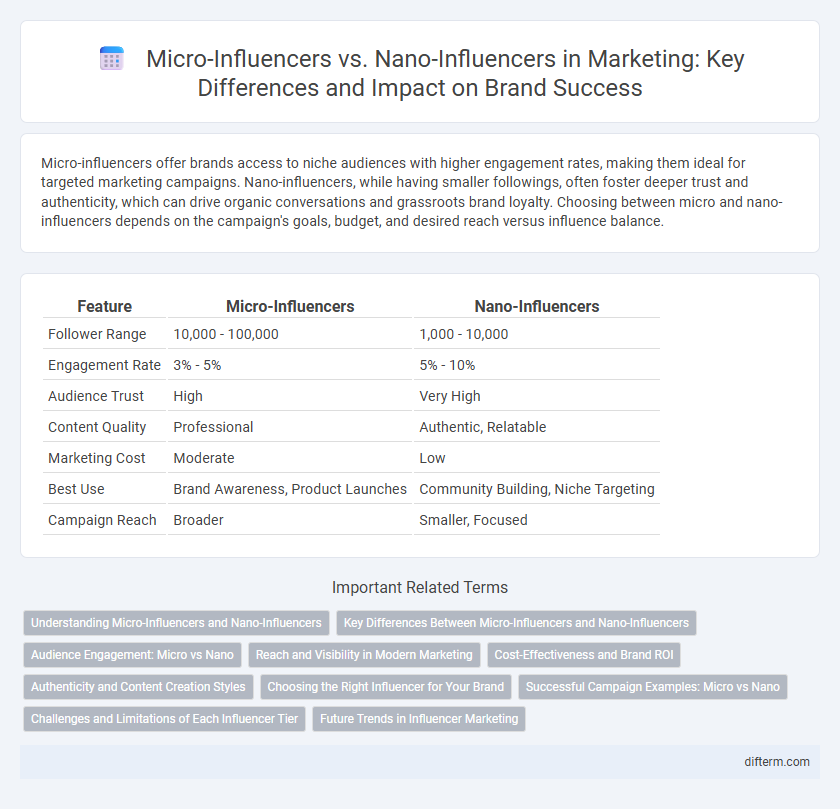Micro-influencers offer brands access to niche audiences with higher engagement rates, making them ideal for targeted marketing campaigns. Nano-influencers, while having smaller followings, often foster deeper trust and authenticity, which can drive organic conversations and grassroots brand loyalty. Choosing between micro and nano-influencers depends on the campaign's goals, budget, and desired reach versus influence balance.
Table of Comparison
| Feature | Micro-Influencers | Nano-Influencers |
|---|---|---|
| Follower Range | 10,000 - 100,000 | 1,000 - 10,000 |
| Engagement Rate | 3% - 5% | 5% - 10% |
| Audience Trust | High | Very High |
| Content Quality | Professional | Authentic, Relatable |
| Marketing Cost | Moderate | Low |
| Best Use | Brand Awareness, Product Launches | Community Building, Niche Targeting |
| Campaign Reach | Broader | Smaller, Focused |
Understanding Micro-Influencers and Nano-Influencers
Micro-influencers typically have 10,000 to 100,000 followers and deliver higher engagement rates due to their niche audiences and authentic content. Nano-influencers, with fewer than 10,000 followers, excel in creating intimate connections and trust within hyper-local or specialized communities. Both influencer types offer brands cost-effective marketing solutions with targeted reach and genuine audience interaction.
Key Differences Between Micro-Influencers and Nano-Influencers
Micro-influencers typically have 10,000 to 100,000 followers, delivering higher reach and moderate engagement rates, while nano-influencers possess fewer than 10,000 followers but boast stronger personal connections and significantly higher engagement percentages. Brands leverage micro-influencers for scalable campaigns targeting niche markets, whereas nano-influencers are preferred for highly authentic, trust-driven promotions within tight-knit communities. Cost per engagement tends to be lower with nano-influencers, making them ideal for budget-conscious marketing strategies focusing on deep audience resonance.
Audience Engagement: Micro vs Nano
Micro-influencers typically boast audience sizes ranging from 10,000 to 100,000 followers, delivering consistent engagement rates around 3-5%, which balances reach with authenticity. Nano-influencers, with follower counts under 10,000, often generate higher engagement rates reaching up to 7-10%, driven by close-knit, trust-based relationships within niche communities. Brands seeking deep audience connection should consider the amplified interaction of nano-influencers alongside the broader impact provided by micro-influencers.
Reach and Visibility in Modern Marketing
Micro-influencers typically boast follower counts between 10,000 and 100,000, enabling them to reach broader niche audiences with high engagement rates, making them ideal for campaigns seeking significant visibility. Nano-influencers, with fewer than 10,000 followers, offer hyper-localized, authentic connections, driving trust and higher engagement within tight-knit communities. Brands leveraging both micro and nano-influencers can optimize reach and visibility by combining wide audience exposure with deep, authentic engagement in modern marketing strategies.
Cost-Effectiveness and Brand ROI
Micro-influencers typically offer a balance between reach and engagement, providing higher brand ROI due to their targeted audiences and reasonable costs, often with follower counts between 10,000 and 100,000. Nano-influencers, with fewer than 10,000 followers, deliver exceptional cost-effectiveness by fostering authentic connections and trust within niche communities, leading to increased conversion rates. Brands leveraging micro- and nano-influencers can optimize marketing budgets by using these tiers strategically to maximize engagement and return on investment.
Authenticity and Content Creation Styles
Micro-influencers command audience sizes ranging from 10,000 to 100,000 followers and excel in producing polished, niche-specific content that emphasizes brand expertise and credibility. Nano-influencers, with fewer than 10,000 followers, prioritize authenticity through relatable, everyday content and foster deeper trust via highly engaged, intimate communities. Both influencer types deliver distinct advantages in marketing strategies, balancing professional quality and genuine connection to optimize audience engagement and conversion.
Choosing the Right Influencer for Your Brand
Micro-influencers, typically with 10,000 to 100,000 followers, offer higher engagement rates and niche audiences ideal for targeted marketing campaigns. Nano-influencers, with fewer than 10,000 followers, provide authentic connections and trustworthy recommendations that boost brand credibility among highly specific communities. Selecting the right influencer involves analyzing your brand's goals, target demographics, and desired engagement quality to maximize ROI and audience resonance.
Successful Campaign Examples: Micro vs Nano
Micro-influencers, typically with 10,000 to 100,000 followers, have driven campaigns like Daniel Wellington's watch launches, generating high engagement and tangible sales growth through authentic, targeted content. Nano-influencers, with fewer than 10,000 followers, excel in hyper-local or niche markets, as seen in Glossier's community-driven campaigns that yielded deep trust and conversion by leveraging highly relatable endorsements. Both scales optimize brand reach and ROI differently, where micro-influencers offer broader but still personalized exposure, and nano-influencers provide intimate, high-trust connections that fuel grassroots momentum.
Challenges and Limitations of Each Influencer Tier
Micro-influencers often face challenges in maintaining engagement rates as their audience size grows, leading to potential declines in authenticity and trust. Nano-influencers struggle with limited reach and resource constraints, which can hinder campaign scalability and brand awareness efforts. Both tiers require strategic balancing between audience size and influence impact to optimize marketing effectiveness.
Future Trends in Influencer Marketing
Micro-influencers with 10,000 to 100,000 followers and nano-influencers with fewer than 10,000 followers are shaping future influencer marketing through authenticity and targeted engagement. Brands increasingly invest in nano-influencers for niche community trust and higher engagement rates. Emerging trends highlight the integration of AI-driven analytics to optimize micro and nano-influencer campaigns, driving personalized marketing strategies and measurable ROI.
Micro-Influencers vs Nano-Influencers Infographic

 difterm.com
difterm.com